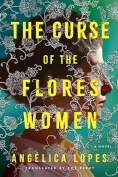The Curse of the Flores Women: A Novel by Angélica Lopes
 Seattle. Amazon Crossing. 2024. 223 pages.
Seattle. Amazon Crossing. 2024. 223 pages.
Angélica Lopes made a name for herself in Brazil as a journalist and soap opera screenwriter. She is also the author of a number of young adult novels. With her first foray into adult fiction, she’s found early success not just in Brazil but also with translations in Italy, France, and now the United States. The Curse of the Flores Women is mainly a historical novel set in 1910s Brazil with an alternating timeline to include a contemporary perspective a hundred years later.
Lopes writes in her author’s note that she intentionally set most of the story just after the turn of the previous century. This was a time when spouses could first legally separate, although not divorce, if they were unhappy in their marriage. Divorce would not become legal in Brazil until 1977, but the 1916 law was groundbreaking because women were no longer obligated to stay in dangerous marriages. At the same time, the lacemaking craft industry was mainly women’s work in Brazil. Lopes pairs both lacemaking and this new ability to leave a marriage in her novel, mostly set in a fictional town called Bom Retiro.
As indicated from the title of the book, the Flores women are cursed. Originally named Oliveria, the women of this family fell under a spell when a male relative jilted his Romani love interest. The spell was to last many generations and was more favorable to women because they would live, but their spouses would die early, leaving these women widows at a young age. Sure enough, whether one believed in the curse or not, the Oliveria women were never married very long before their husbands died from one cause or another. After a while, to draw attention away from their fate, the family changed its name to Flores after the many flowers they grew in their gardens.
The Flores women worked as lacemakers, a profession by which they could support themselves. After all, they knew not to rely on the men in their family because they would never be around for very long. Ines Flores is the narrator of the storyline set in the 1910s and has a friend named Eugenia, who is not related yet works very closely with the Flores women in making lace. Eugenia’s father agrees to marry her to a widowed colonel with a couple of young children. The colonel speaks not one word during the pair’s two meetings before their wedding. Eugenia is only fifteen and is not ready to marry. To express her displeasure and fear that she will become a prisoner in her new home, she devises a special language expressed in stitches. She sends the written key of this language to the Flores women, and Ines becomes an accomplice in Eugenia’s later plans to leave the colonel. The women communicate through this secret language in their lacework. Making lace is about the only pastime Eugenia can enjoy under the colonel’s roof.
Although the contemporary storyline is not imperative to the story of Eugenia, Ines, and the other Flores women, Lopes adds another layer to her novel by including Alice, a Brazilian American woman and a descendant of the Flores family. Alice’s father left her family when Alice was still very young, so like her predecessors, she and her mother are not used to having a man in the family. When a distant relative from Brazil visits Alice in the United States and brings an old lace veil, Alice learns about—and becomes intrigued by—the secret language of the stitches. Alice eventually travels to Brazil to learn more about her predecessors and maybe, finally, break the curse that has plagued the Flores women for more than a hundred years.
Susan Blumberg-Kason
Hinsdale, Illinois






























